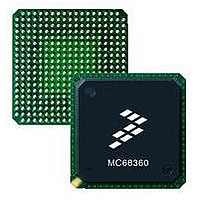MC68EN360CAI25L Freescale Semiconductor, MC68EN360CAI25L Datasheet - Page 57

MC68EN360CAI25L
Manufacturer Part Number
MC68EN360CAI25L
Description
IC MPU QUICC 25MHZ 240-FQFP
Manufacturer
Freescale Semiconductor
Series
MC68000r
Datasheets
1.MC68EN302AG20BT.pdf
(8 pages)
2.MC68EN360VR25L.pdf
(14 pages)
3.MC68EN360VR25L.pdf
(2 pages)
4.MC68EN360CAI25L.pdf
(962 pages)
Specifications of MC68EN360CAI25L
Processor Type
M683xx 32-Bit
Speed
25MHz
Voltage
5V
Mounting Type
Surface Mount
Package / Case
240-FQFP
Core Size
32 Bit
Cpu Speed
25MHz
Embedded Interface Type
SCP, TDM
Digital Ic Case Style
FQFP
No. Of Pins
240
Supply Voltage Range
4.75V To 5.25V
Rohs Compliant
Yes
Family Name
M68xxx
Device Core
ColdFire
Device Core Size
32b
Frequency (max)
25MHz
Instruction Set Architecture
RISC
Supply Voltage 1 (typ)
5V
Operating Supply Voltage (max)
5.25V
Operating Supply Voltage (min)
4.75V
Operating Temp Range
-40C to 85C
Operating Temperature Classification
Industrial
Mounting
Surface Mount
Pin Count
240
Package Type
FQFP
Lead Free Status / RoHS Status
Lead free / RoHS Compliant
Features
-
Lead Free Status / Rohs Status
Compliant
Available stocks
Company
Part Number
Manufacturer
Quantity
Price
Company:
Part Number:
MC68EN360CAI25L
Manufacturer:
APLHA
Quantity:
12 000
Company:
Part Number:
MC68EN360CAI25L
Manufacturer:
Freescale Semiconductor
Quantity:
10 000
Part Number:
MC68EN360CAI25L
Manufacturer:
FREESCALE
Quantity:
20 000
- MC68EN302AG20BT PDF datasheet
- MC68EN360VR25L PDF datasheet #2
- MC68EN360VR25L PDF datasheet #3
- MC68EN360CAI25L PDF datasheet #4
- Current page: 57 of 962
- Download datasheet (4Mb)
2.1.7.7 OUTPUT ENABLE/ADDRESS MULTIPLEX (OE/AMUX). This pin can be pro-
grammed as the output enable (OE) output or as the address multiplex output.
OE—During a read cycle, this output signal is driven by the bus master to indicate that an
external device should place valid data on the data bus. OE may used to save an external
inversion of the R/W signal.
AMUX—This output signal is driven by the DRAM controller to the external address multi-
plexer. AMUX need not be used if the DRAM addresses are multiplexed internally by the
QUICC.
2.1.7.8 BYTE WRITE ENABLE (WE3–WE0) . See 2.1.1.2 Address Bus (A31–A28) for the
description.
2.1.8 Bus Arbitration Signals
The following signals are the four bus arbitration control signals used to determine the bus
master. Refer to Section 4 Bus Operation for more information concerning these signals.
2.1.8.1 BUS REQUEST (BR). This active-low input signal indicates that an external device
needs to become the bus master. This input is typically wire-ORed.
2.1.8.2 BUS GRANT (BG). Assertion of this active-low output signal indicates that the bus
master has relinquished the bus.
2.1.8.3 BUS GRANT ACKNOWLEDGE (BGACK). Assertion of this active-low input indi-
cates that an external device has become the bus master.
2.1.8.4 READ-MODIFY-WRITE CYCLE/INITIAL CONFIGURATION (RMC/CONFIG0).
This pin can be programmed as the read-modify-write cycle output or as the initial configu-
ration pin 0 input signal during system reset.
RMC—This output signal identifies the bus cycle as part of an indivisible read-modify-write
operation; it remains asserted during all bus cycles of the read-modify-write operation to
indicate that bus ownership cannot be transferred.
CONFIG0—See 2.1.13 Initial Configuration Pins (CONFIG) for the description.
2.1.8.5 BUS CLEAR OUT/INITIAL CONFIGURATION/ROW ADDRESS SELECT
DOUBLE-DRIVE (BCLRO/CONFIG1/RAS2DD). This pin can be programmed as the bus
clear out output or as the initial configuration pin 1 input signal during system reset or as the
RAS2DD output double-drive signal.
RMC is muxed with a CONFIG0 pin. RMC only functions when
the CPU32+ is enabled, and is an output unless an external
master ownes the bus, in which case it is an input.
Freescale Semiconductor, Inc.
For More Information On This Product,
MC68360 USER’S MANUAL
Go to: www.freescale.com
NOTE
Signal Descriptions
Related parts for MC68EN360CAI25L
Image
Part Number
Description
Manufacturer
Datasheet
Request
R
Part Number:
Description:
Manufacturer:
Freescale Semiconductor, Inc
Datasheet:
Part Number:
Description:
Manufacturer:
Freescale Semiconductor, Inc
Datasheet:
Part Number:
Description:
Manufacturer:
Freescale Semiconductor, Inc
Datasheet:
Part Number:
Description:
Manufacturer:
Freescale Semiconductor, Inc
Datasheet:
Part Number:
Description:
Manufacturer:
Freescale Semiconductor, Inc
Datasheet:
Part Number:
Description:
Manufacturer:
Freescale Semiconductor, Inc
Datasheet:
Part Number:
Description:
Manufacturer:
Freescale Semiconductor, Inc
Datasheet:
Part Number:
Description:
Manufacturer:
Freescale Semiconductor, Inc
Datasheet:
Part Number:
Description:
Manufacturer:
Freescale Semiconductor, Inc
Datasheet:
Part Number:
Description:
Manufacturer:
Freescale Semiconductor, Inc
Datasheet:
Part Number:
Description:
Manufacturer:
Freescale Semiconductor, Inc
Datasheet:
Part Number:
Description:
Manufacturer:
Freescale Semiconductor, Inc
Datasheet:
Part Number:
Description:
Manufacturer:
Freescale Semiconductor, Inc
Datasheet:
Part Number:
Description:
Manufacturer:
Freescale Semiconductor, Inc
Datasheet:
Part Number:
Description:
Manufacturer:
Freescale Semiconductor, Inc
Datasheet:











